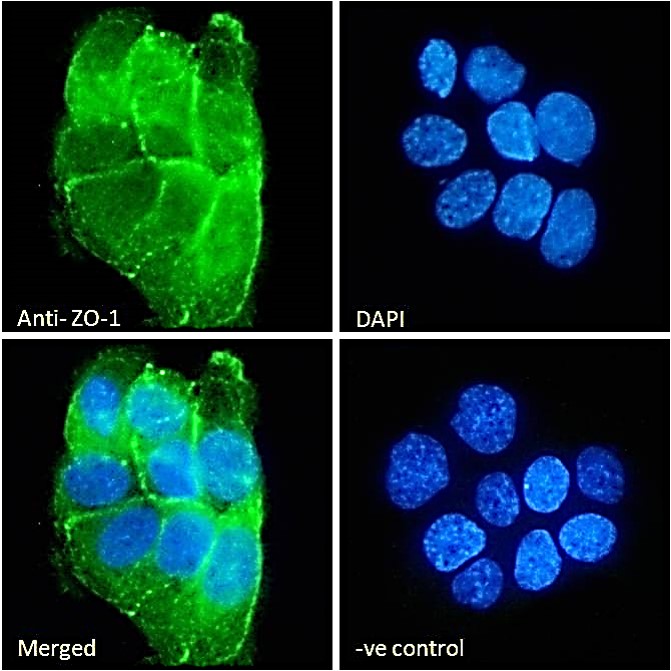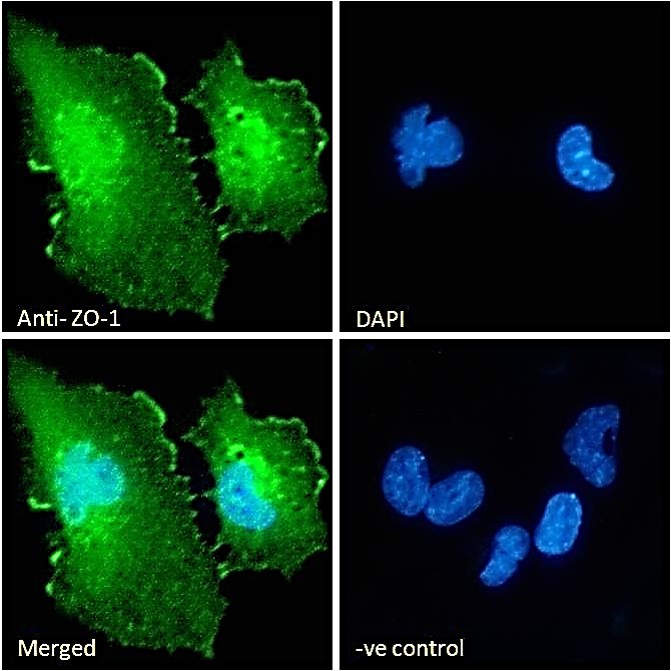Goat Anti-ZO-1 Antibody
Peptide-affinity purified goat antibody
- SPECIFICATION
- CITATIONS
- PROTOCOLS
- BACKGROUND

Application
| IF, Pep-ELISA |
|---|---|
| Primary Accession | Q07157 |
| Other Accession | NP_783297, 7082 |
| Reactivity | Human |
| Host | Goat |
| Clonality | Polyclonal |
| Concentration | 100ug/200ul |
| Isotype | IgG |
| Calculated MW | 195459 Da |
| Gene ID | 7082 |
|---|---|
| Other Names | Tight junction protein ZO-1, Tight junction protein 1, Zona occludens protein 1, Zonula occludens protein 1, TJP1, ZO1 |
| Dilution | IF~~1:50~200 Pep-ELISA~~N/A |
| Format | 0.5 mg IgG/ml in Tris saline (20mM Tris pH7.3, 150mM NaCl), 0.02% sodium azide, with 0.5% bovine serum albumin |
| Storage | Maintain refrigerated at 2-8°C for up to 6 months. For long term storage store at -20°C in small aliquots to prevent freeze-thaw cycles. |
| Precautions | Goat Anti-ZO-1 Antibody is for research use only and not for use in diagnostic or therapeutic procedures. |
| Name | TJP1 (HGNC:11827) |
|---|---|
| Function | TJP1, TJP2, and TJP3 are closely related scaffolding proteins that link tight junction (TJ) transmembrane proteins such as claudins, junctional adhesion molecules, and occludin to the actin cytoskeleton (PubMed:7798316, PubMed:9792688). Forms a multistranded TJP1/ZO1 condensate which elongates to form a tight junction belt, the belt is anchored at the apical cell membrane via interaction with PATJ (By similarity). The tight junction acts to limit movement of substances through the paracellular space and as a boundary between the compositionally distinct apical and basolateral plasma membrane domains of epithelial and endothelial cells. Necessary for lumenogenesis, and particularly efficient epithelial polarization and barrier formation (By similarity). Plays a role in the regulation of cell migration by targeting CDC42BPB to the leading edge of migrating cells (PubMed:21240187). Plays an important role in podosome formation and associated function, thus regulating cell adhesion and matrix remodeling (PubMed:20930113). With TJP2 and TJP3, participates in the junctional retention and stability of the transcription factor DBPA, but is not involved in its shuttling to the nucleus (By similarity). May play a role in mediating cell morphology changes during ameloblast differentiation via its role in tight junctions (By similarity). |
| Cellular Location | Cell membrane; Peripheral membrane protein; Cytoplasmic side. Cell junction, tight junction. Cell junction. Cell junction, gap junction. Cell projection, podosome. Note=Moves from the cytoplasm to the cell membrane concurrently with cell-cell contact (PubMed:7798316). Forms a condensed tight junction-linked belt of protein during junction formation which becomes anchored to the apical cell membrane via interaction with PATJ (By similarity). At podosomal sites, is predominantly localized in the ring structure surrounding the actin core (PubMed:20930113). Colocalizes with SPEF1 at sites of cell- cell contact in intestinal epithelial cells (PubMed:31473225) {ECO:0000250|UniProtKB:O97758, ECO:0000269|PubMed:20930113, ECO:0000269|PubMed:31473225, ECO:0000269|PubMed:7798316} |
| Tissue Location | The alpha-containing isoform is found in most epithelial cell junctions. The short isoform is found both in endothelial cells and the highly specialized epithelial junctions of renal glomeruli and Sertoli cells of the seminiferous tubules |

Thousands of laboratories across the world have published research that depended on the performance of antibodies from Abcepta to advance their research. Check out links to articles that cite our products in major peer-reviewed journals, organized by research category.
info@abcepta.com, and receive a free "I Love Antibodies" mug.
Provided below are standard protocols that you may find useful for product applications.
Background
This gene encodes a protein located on a cytoplasmic membrane surface of intercellular tight junctions. The encoded protein may be involved in signal transduction at cell-cell junctions. Two transcript variants encoding distinct isoforms have been identified for this gene.
References
Diesel exhaust particles modulate vascular endothelial cell permeability: implication of ZO-1 expression. Li R, et al. Toxicol Lett, 2010 Sep 1. PMID 20576493.
ZO-1 is involved in trophoblastic cell differentiation in human placenta. Pidoux G, et al. Am J Physiol Cell Physiol, 2010 Jun. PMID 20200207.
Insights into regulated ligand binding sites from the structure of ZO-1 Src homology 3-guanylate kinase module. Lye MF, et al. J Biol Chem, 2010 Apr 30. PMID 20200156.
Hypercholesterolaemic serum increases the permeability of endothelial cells through zonula occludens-1 with phosphatidylinositol 3-kinase signaling pathway. Bian C, et al. J Biomed Biotechnol, 2009. PMID 20150971.
Dislocation of Rab13 and vasodilator-stimulated phosphoprotein in inactive colon epithelium in patients with Crohn's disease. Ohira M, et al. Int J Mol Med, 2009 Dec. PMID 19885626.
If you have used an Abcepta product and would like to share how it has performed, please click on the "Submit Review" button and provide the requested information. Our staff will examine and post your review and contact you if needed.
If you have any additional inquiries please email technical services at tech@abcepta.com.













 Foundational characteristics of cancer include proliferation, angiogenesis, migration, evasion of apoptosis, and cellular immortality. Find key markers for these cellular processes and antibodies to detect them.
Foundational characteristics of cancer include proliferation, angiogenesis, migration, evasion of apoptosis, and cellular immortality. Find key markers for these cellular processes and antibodies to detect them. The SUMOplot™ Analysis Program predicts and scores sumoylation sites in your protein. SUMOylation is a post-translational modification involved in various cellular processes, such as nuclear-cytosolic transport, transcriptional regulation, apoptosis, protein stability, response to stress, and progression through the cell cycle.
The SUMOplot™ Analysis Program predicts and scores sumoylation sites in your protein. SUMOylation is a post-translational modification involved in various cellular processes, such as nuclear-cytosolic transport, transcriptional regulation, apoptosis, protein stability, response to stress, and progression through the cell cycle. The Autophagy Receptor Motif Plotter predicts and scores autophagy receptor binding sites in your protein. Identifying proteins connected to this pathway is critical to understanding the role of autophagy in physiological as well as pathological processes such as development, differentiation, neurodegenerative diseases, stress, infection, and cancer.
The Autophagy Receptor Motif Plotter predicts and scores autophagy receptor binding sites in your protein. Identifying proteins connected to this pathway is critical to understanding the role of autophagy in physiological as well as pathological processes such as development, differentiation, neurodegenerative diseases, stress, infection, and cancer.




